Tectonic Geodesy Synthesis and Review of the North Aegean Region, Based on the Strain Patterns of the North Aegean Sea, Strymon Basin and Thessalian Basin Case Studies
Abstract
:1. Introduction
2. Geodetic Studies of the Aegean Region
3. Materials and Methods
3.1. Maximum (MaHE) and Minimum (MiHE) Horizontal Extension
- is the final length along the strain ellipse major axis,
- is the original length along the strain ellipse major axis,
- is the final length along the strain ellipse minor axis, and
- is the original length along the strain ellipse minor axis.
3.2. Maximum Shear Strain (MaxSS)
3.3. Area Strain (AS)
4. Results
4.1. Synthesis of Strain Results
4.1.1. Maximum (MaHE) and Minimum (MiHE) Horizontal Extension
4.1.2. Maximum Shear Strain (MaxSS)
4.1.3. Area Strain (AS)
5. Discussion and Conclusions
Author Contributions
Funding
Institutional Review Board Statement
Informed Consent Statement
Data Availability Statement
Acknowledgments
Conflicts of Interest
References
- Bevis, M. GPS Networks: The Practical Side. Eos Trans. Am. Geophys. Union. 1991, 72, 49. [Google Scholar] [CrossRef]
- Segall, P.; Davis, J.L. GPS Applications for Geodynamics and Earthquake Studies. Annu. Rev. Earth Planet. Sci. 1997, 25, 301–336. [Google Scholar] [CrossRef]
- McKenzie, D. Active Tectonics of the Mediterranean Region. Geophys. J. Int. 1972, 30, 109–185. [Google Scholar] [CrossRef]
- Taymaz, T.; Jackson, J.; McKenzie, D. Active Tectonics of the North and Central Aegean Sea. Geophys. J. Int. 1991, 106, 433–490. [Google Scholar] [CrossRef]
- Jolivet, L.; Faccenna, C.; Huet, B.; Labrousse, L.; Le Pourhiet, L.; Lacombe, O.; Lecomte, E.; Burov, E.; Denèle, Y.; Brun, J.P.; et al. Aegean Tectonics: Strain Localisation, Slab Tearing and Trench Retreat. Tectonophysics 2013, 597–598, 1–33. [Google Scholar] [CrossRef]
- Brun, J.P.; Faccenna, C. Exhumation of High-Pressure Rocks Driven by Slab Rollback. Earth Planet. Sci. Lett. 2008, 272, 1–7. [Google Scholar] [CrossRef]
- Philippon, M.; Brun, J.P.; Gueydan, F.; Sokoutis, D. The Interaction between Aegean Back-Arc Extension and Anatolia Escape since Middle Miocene. Tectonophysics 2014, 631, 176–188. [Google Scholar] [CrossRef]
- Erman, C.; Yolsal-Çevikbilen, S.; Eken, T.; Tilmann, F.; Keleş, D.; Taymaz, T. Constraints on the Lithospheric Kinematics in the Aegean and Western Anatolia Unveiled by SKS Splitting Observations. J. Geophys. Res. Solid. Earth 2022, 127, e2022JB025265. [Google Scholar] [CrossRef]
- Le Pichon, X.; Angelier, J. The Hellenic Arc and Trench System: A Key to the Neotectonic Evolution of the Eastern Mediterranean Area. Tectonophysics 1979, 60, 1–42. [Google Scholar] [CrossRef]
- Taymaz, T.; Yilmaz, Y.; Dilek, Y. The Geodynamics of the Aegean and Anatolia: Introduction. Geol. Soc. Spec. Publ. 2007, 291, 1–16. [Google Scholar] [CrossRef]
- Meijer, P.T.; Wortel, M.J.R. Present-Day Dynamics of the Aegean Region: A Model Analysis of the Horizontal Pattern of Stress and Deformation. Tectonics 1997, 16, 879–895. [Google Scholar] [CrossRef]
- McKenzie, D.; Jackson, J. Conditions for Flow in the Continental Crust. Tectonics 2002, 21, 5-1–5-7. [Google Scholar] [CrossRef]
- Sodoudi, F.; Kind, R.; Hatzfeld, D.; Priestley, K.; Hanka, W.; Wylegalla, K.; Stavrakakis, G.; Vafidis, A.; Harjes, H.P.; Bohnhoff, M. Lithospheric Structure of the Aegean Obtained from P and S Receiver Functions. J. Geophys. Res. Solid. Earth 2006, 111, B12307. [Google Scholar] [CrossRef]
- Jolivet, L.; Menant, A.; Clerc, C.; Sternai, P.; Bellahsen, N.; Leroy, S.; Pik, R.; Stab, M.; Faccenna, C.; Gorini, C. Extensional Crustal Tectonics and Crust-Mantle Coupling, a View from the Geological Record. Earth Sci. Rev. 2018, 185, 1187–1209. [Google Scholar] [CrossRef]
- Sboras, S.; Chatzipetros, A.; Pavlides, S. North Aegean Active Fault Pattern and the 24 May 2014, Mw 6.9 Earthquake. In Active Global Seismology Neotectonics and Earthquake Potential. of the Eastern Mediterranean Region; John Wiley & Sons, Inc.: Hoboken, NJ, USA, 2017; pp. 239–272. ISBN 9781118944998. [Google Scholar]
- Reilinger, R.; McClusky, S.; Paradissis, D.; Ergintav, S.; Vernant, P. Geodetic Constraints on the Tectonic Evolution of the Aegean Region and Strain Accumulation along the Hellenic Subduction Zone. Tectonophysics 2010, 488, 22–30. [Google Scholar] [CrossRef]
- Lazos, I.; Papanikolaou, I.; Sboras, S.; Foumelis, M.; Pikridas, C. Geodetic Upper Crust Deformation Based on Primary GNSS and INSAR Data in the Strymon Basin, Northern Greece-Correlation with Active Faults. Appl. Sci. 2022, 12, 9391. [Google Scholar] [CrossRef]
- Brooks, M.; Ferentinos, G. Structure and Evolution of the Sporadhes Basin of the North Aegean Trough, Northern Aegean Sea. Tectonophysics 1980, 68, 15–30. [Google Scholar] [CrossRef]
- Karakostas, V.G.; Papadimitriou, E.E.; Karakaisis, G.F.; Papazachos, C.B.; Scordilis, E.M.; Vargemezis, G.; Aidona, E. The 2001 Skyros, Northern Aegean, Greece, Earthquake Sequence: Off-Fault Aftershocks, Tectonic Implications, and Seismicity Triggering. Geophys. Res. Lett. 2003, 30, 12-1–12-14. [Google Scholar] [CrossRef]
- Papanikolaou, D.; Nomikou, P.; Papanikolaou, I.; Lampridou, D.; Rousakis, G.; Alexandri, M. Active Tectonics and Seismic Hazard in Skyros Basin, North Aegean Sea, Greece. Mar. Geol. 2019, 407, 94–110. [Google Scholar] [CrossRef]
- McNeill, L.C.; Mille, A.; Minshull, T.A.; Bull, J.M.; Kenyon, N.H.; Ivanov, M. Extension of the North Anatolian Fault into the North Aegean Trough: Evidence for Transtension, Strain Partitioning, and Analogues for Sea of Marmara Basin Models. Tectonics 2004, 23, TC2016. [Google Scholar] [CrossRef]
- Papanikolaou, D.; Alexandri, M.; Nomikou, P. Active Faulting in the North Aegean Basin. Spec. Pap. Geol. Soc. Am. 2006, 409, 189–209. [Google Scholar] [CrossRef]
- Lazos, I.; Sboras, S.; Chousianitis, K.; Kondopoulou, D.; Pikridas, C.; Bitharis, S.; Pavlides, S. Temporal Evolution of Crustal Rotation in the Aegean Region Based on Primary Geodetically-Derived Results and Palaeomagnetism. Acta Geod. Geophys. 2022, 57, 317–334. [Google Scholar] [CrossRef]
- Robertson, A.; Dixon, J. Introduction: Aspects of the Geological Evolution of the Eastern Mediterranean. Geol. Soc. Lond. Spec. Publ. 1984, 17, 1–74. [Google Scholar] [CrossRef]
- Mascle, J.; Martin, L. Shallow Structure and Recent Evolution of the Aegean Sea: A Synthesis Based on Continuous Reflection Profiles. Mar. Geol. 1990, 94, 271–299. [Google Scholar] [CrossRef]
- Papanikolaou, D.J.; Royden, L.H. Disruption of the Hellenic Arc: Late Miocene Extensional Detachment Faults and Steep Pliocene-Quaternary Normal Faults-Or What Happened at Corinth? Tectonics 2007, 26, TC5003. [Google Scholar] [CrossRef]
- Jolivet, L.; Brun, J.P. Cenozoic Geodynamic Evolution of the Aegean. Int. J. Earth Sci. 2010, 99, 109–138. [Google Scholar] [CrossRef]
- Brun, J.P.; Sokoutis, D. Core Complex Segmentation in North Aegean, A Dynamic View. Tectonics 2018, 37, 1797–1830. [Google Scholar] [CrossRef]
- Dewey, J.F.; Sengör, A.M.C. Aegean and Surrounding Regions. Complex Multiplate and Continuum Tectonics in a Convergent Zone. Geol. Soc. Am. Bull. 1979, 90, 84–92. [Google Scholar] [CrossRef]
- Mercier, J.L.; Sorel, D.; Vergely, P.; Simeakis, K. Extensional Tectonic Regimes in the Aegean Basins during the Cenozoic. Basin Res. 1989, 2, 49–71. [Google Scholar] [CrossRef]
- Koukouvelas, I.; Aydin, A. Fault Structure and Related Basins of the North Aegean Sea and Its Surroundings. Tectonics 2002, 21, 10-1–10-17. [Google Scholar] [CrossRef]
- Sternai, P.; Jolivet, L.; Menant, A.; Gerya, T. Driving the Upper Plate Surface Deformation by Slab Rollback and Mantle Flow. Earth Planet. Sci. Lett. 2014, 405, 110–118. [Google Scholar] [CrossRef]
- Bocchini, G.M.; Brüstle, A.; Becker, D.; Meier, T.; van Keken, P.E.; Ruscic, M.; Papadopoulos, G.A.; Rische, M.; Friederich, W. Tearing, Segmentation, and Backstepping of Subduction in the Aegean: New Insights from Seismicity. Tectonophysics 2018, 734–735, 96–118. [Google Scholar] [CrossRef]
- Lybéris, N. Tectonic Evolution of the North Aegean Trough. Geol. Soc. Lond. Spec. Publ. 1984, 17, 709–725. [Google Scholar] [CrossRef]
- Dinter, D.A.; Royden, L. Late Cenozoic Extension in Northeastern Greece: Strymon Valley Detachment System and Rhodope Metamorphic Core Complex. Geology 1993, 21, 45–48. [Google Scholar] [CrossRef]
- Pavlides, S.; Kilias, A. Neotectonic and Active Faults along the Serbomacedonian Zone (SE Chalkidiki, Northern Greece). Ann. Tecton. 1987, 1, 97–104. [Google Scholar]
- Mountrakis, D.; Tranos, M.; Papazachos, C.; Thomaidou, E.; Karagianni, E.; Vamvakaris, D. Neotectonic and Seismological Data Concerning Major Active Faults, and the Stress Regimes of Northern Greece. Geol. Soc. Spec. Publ. 2006, 260, 649–670. [Google Scholar] [CrossRef]
- Cerrone, C.; Di Donato, V.; Mazzoli, S.; Robustelli, G.; Soligo, M.; Tuccimei, P.; Ascione, A. Development and Deformation of Marine Terraces: Constraints to the Evolution of the Campania Plain Quaternary Coastal Basin (Italy). Geomorphology 2021, 385, 107725. [Google Scholar] [CrossRef]
- Sboras, S. The Greek Database of Seismogenic Sources: Seismotectonic Implications for North Greece; University of Ferrara: Ferrara, Italy, 2011. [Google Scholar]
- Caputo, R.; Chatzipetros, A.; Pavlides, S.; Sboras, S. The Greek Database of Seismogenic Sources (GreDaSS): State-of-the-Art for Northern Greece. Ann. Geophys. 2012, 55, 859–894. [Google Scholar] [CrossRef]
- Noomen, R.; Springer, T.A.; Ambrosius, B.A.C.; Herzberger, K.; Kuijper, D.C.; Mets, G.-J.; Overgaauw, B.; Wakker, K.F. Crustal Deformations in the Mediterranean Area Computed from SLR and GPS Observations. J. Geodyn. 1996, 21, 73–96. [Google Scholar] [CrossRef]
- Becker, M. Assessment of Height Variations by GPS at Mediterranean and Black Sea Coast Tide Gauges from the SELF Projects. Glob. Planet. Change 2002, 34, 5–35. [Google Scholar] [CrossRef]
- Pérouse, E.; Chamot-Rooke, N.; Rabaute, A.; Briole, P.; Jouanne, F.; Georgiev, I.; Dimitrov, D. Bridging Onshore and Offshore Present-Day Kinematics of Central and Eastern Mediterranean: Implications for Crustal Dynamics and Mantle Flow. Geochem. Geophys. Geosyst. 2012, 13, Q09013. [Google Scholar] [CrossRef]
- Müller, M.D.; Geiger, A.; Kahle, H.G.; Veis, G.; Billiris, H.; Paradissis, D.; Felekis, S. Velocity and Deformation Fields in the North Aegean Domain, Greece, and Implications for Fault Kinematics, Derived from GPS Data 1993–2009. Tectonophysics 2013, 597–598, 34–49. [Google Scholar] [CrossRef]
- Serpelloni, E.; Faccenna, C.; Spada, G.; Dong, D.; Williams, S.D.P. Vertical GPS Ground Motion Rates in the Euro-Mediterranean Region: New Evidence of Velocity Gradients at Different Spatial Scales along the Nubia-Eurasia Plate Boundary. J. Geophys. Res. Solid. Earth 2013, 118, 6003–6024. [Google Scholar] [CrossRef]
- Jenny, S.; Goes, S.; Giardini, D.; Kahle, H.G. Earthquake Recurrence Parameters from Seismic and Geodetic Strain Rates in the Eastern Mediterranean. Geophys. J. Int. 2004, 157, 1331–1347. [Google Scholar] [CrossRef]
- Kahle, H.G.; Straub, C.; Reilinger, R.; McClusky, S.; King, R.; Hurst, K.; Veis, G.; Kastens, K.; Cross, P. The Strain Rate Field in the Eastern Mediterranean Region, Estimated by Repeated GPS Measurements. Tectonophysics 1998, 294, 237–252. [Google Scholar] [CrossRef]
- Billiris, H.; Paradissis, D.; Veis, G.; England, P.; Featherstone, W.; Parsons, B.; Cross, P.; Rands, P.; Rayson, M.; Sellers, P.; et al. Geodetic Determination of Tectonic Deformation in Central Greece from 1900 to 1988. Nature 1991, 350, 124–129. [Google Scholar] [CrossRef]
- Clarke, P.J.; Davies, R.R.; England, P.C.; Parsons, B.; Billiris, H.; Paradissis, D.; Veis, G.; Cross, P.A.; Denys, P.H.; Ashkenazi, V.; et al. Crustal Strain in Central Greece from Repeated GPS Measurements in the Interval 1989–1997. Geophys. J. Int. 1998, 135, 195–214. [Google Scholar] [CrossRef]
- Chousianitis, K.; Ganas, A.; Evangelidis, C.P. Strain and Rotation Rate Patterns of Mainland Greece from Continuous GPS Data and Comparison between Seismic and Geodetic Moment Release. J. Geophys. Res. Solid. Earth 2015, 120, 3909–3931. [Google Scholar] [CrossRef]
- England, P.; Houseman, G.; Nocquet, J.-M. Constraints from GPS Measurements on the Dynamics of Deformation in Anatolia and the Aegean. J. Geophys. Res. Solid. Earth 2016, 121, 8888–8916. [Google Scholar] [CrossRef]
- D’Agostino, N.; Métois, M.; Koci, R.; Duni, L.; Kuka, N.; Ganas, A.; Georgiev, I.; Jouanne, F.; Kaludjerovic, N.; Kandić, R. Active Crustal Deformation and Rotations in the Southwestern Balkans from Continuous GPS Measurements. Earth Planet. Sci. Lett. 2020, 539, 116246. [Google Scholar] [CrossRef]
- Caporali, A.; Aichhorn, C.; Barlik, M.; Becker, M.; Fejes, I.; Gerhatova, L.; Ghitau, D.; Grenerczy, G.; Hefty, J.; Krauss, S.; et al. Surface Kinematics in the Alpine-Carpathian-Dinaric and Balkan Region Inferred from a New Multi-Network GPS Combination Solution. Tectonophysics 2009, 474, 295–321. [Google Scholar] [CrossRef]
- Le Pichon, X.; Chamot-Rooke, N.; Lallemant, S.; Noomen, R.; Veis, G. Geodetic Determination of the Kinematics of Central Greece with Respect to Europe: Implications for Eastern Mediterranean Tectonics. J. Geophys. Res. 1995, 100, 12675–12690. [Google Scholar] [CrossRef]
- McClusky, S.; Balassanian, S.; Barka, A.; Demir, C.; Ergintav, S.; Georgiev, I.; Gurkan, O.; Hamburger, M.; Hurst, K.; Kahle, H.; et al. Global Positioning System Constraints on Plate Kinematics and Dynamics in the Eastern Mediterranean and Caucasus. J. Geophys. Res. 2000, 105, 5695. [Google Scholar] [CrossRef]
- Kahle, H.G.; Cocard, M.; Peter, Y.; Geiger, A.; Reilinger, R.; Barka, A.; Veis, G. GPS-Derived Strain Rate Field within the Boundary Zones of the Eurasian, African, and Arabian Plates. J. Geophys. Res. Solid. Earth 2000, 105, 23353–23370. [Google Scholar] [CrossRef]
- Nyst, M.; Thatcher, W. New Constraints on the Active Tectonic Deformation of the Aegean. J. Geophys. Res. B Solid. Earth 2004, 109, 1–23. [Google Scholar] [CrossRef]
- Nocquet, J.M. Present-Day Kinematics of the Mediterranean: A Comprehensive Overview of GPS Results. Tectonophysics 2012, 579, 220–242. [Google Scholar] [CrossRef]
- Simpson, R.W.; Thatcher, W.; Savage, J.C. Using Cluster Analysis to Organize and Explore Regional GPS Velocities. Geophys. Res. Lett. 2012, 39, L18307. [Google Scholar] [CrossRef]
- Avallone, A.; Briole, P.; Agatza-Balodimou, A.M.; Billiris, H.; Charade, O.; Mitsakaki, C.; Nercessian, A.; Papazissi, K.; Paradissis, D.; Veis, G. Analysis of Eleven Years of Deformation Measured by GPS in the Corinth Rift Laboratory Area. Comptes Rendus Geosci. 2004, 336, 301–311. [Google Scholar] [CrossRef]
- Floyd, M.A.; Billiris, H.; Paradissis, D.; Veis, G.; Avallone, A.; Briole, P.; McClusky, S.; Nocquet, J.-M.; Palamartchouk, K.; Parsons, B.; et al. A New Velocity Field for Greece: Implications for the Kinematics and Dynamics of the Aegean. J. Geophys. Res. 2010, 115, B10403. [Google Scholar] [CrossRef]
- Cocard, M.; Kahle, H.G.; Peter, Y.; Geiger, A.; Veis, G.; Felekis, S.; Paradissis, D.; Billiris, H. New Constraints on the Rapid Crustal Motion of the Aegean Region: Recent Results Inferred from GPS Measurements (1993-1998) across the West Hellenic Arc, Greece. Earth Planet. Sci. Lett. 1999, 172, 39–47. [Google Scholar] [CrossRef]
- Briole, P.; Rigo, A.; Lyon-Caen, H.; Ruegg, J.C.; Papazissi, K.; Mitsakaki, C.; Balodimou, A.; Veis, G.; Hatzfeld, D.; Deschamps, A. Active Deformation of the Corinth Rift, Greece: Results from Repeated Global Positioning System Surveys between 1990 and 1995. J. Geophys. Res. Solid. Earth 2000, 105, 25605–25625. [Google Scholar] [CrossRef]
- Lagios, E.; Sakkas, V.; Papadimitriou, P.; Parcharidis, I.; Damiata, B.N.; Chousianitis, K.; Vassilopoulou, S. Crustal Deformation in the Central Ionian Islands (Greece): Results from DGPS and DInSAR Analyses (1995–2006). Tectonophysics 2007, 444, 119–145. [Google Scholar] [CrossRef]
- Hollenstein, C.; Müller, M.D.; Geiger, A.; Kahle, H.G. Crustal Motion and Deformation in Greece from a Decade of GPS Measurements, 1993-2003. Tectonophysics 2008, 449, 17–40. [Google Scholar] [CrossRef]
- Reilinger, R.; McClusky, S.; Vernant, P.; Lawrence, S.; Ergintav, S.; Cakmak, R.; Ozener, H.; Kadirov, F.; Guliev, I.; Stepanyan, R.; et al. GPS Constraints on Continental Deformation in the Africa-Arabia-Eurasia Continental Collision Zone and Implications for the Dynamics of Plate Interactions. J. Geophys. Res. Solid. Earth 2006, 111, B05411. [Google Scholar] [CrossRef]
- Vernant, P.; Reilinger, R.; McClusky, S. Geodetic Evidence for Low Coupling on the Hellenic Subduction Plate Interface. Earth Planet. Sci. Lett. 2014, 385, 122–129. [Google Scholar] [CrossRef]
- Faccenna, C.; Bellier, O.; Martinod, J.; Piromallo, C.; Regard, V. Slab Detachment beneath Eastern Anatolia: A Possible Cause for the Formation of the North Anatolian Fault. Earth Planet. Sci. Lett. 2006, 242, 85–97. [Google Scholar] [CrossRef]
- Reilinger, R.; McClusky, S. Nubia-Arabia-Eurasia Plate Motions and the Dynamics of Mediterranean and Middle East Tectonics. Geophys. J. Int. 2011, 186, 971–979. [Google Scholar] [CrossRef]
- Mantovani, E.; Babbucci, D.; Tamburelli, C.; Viti, M. Late Cenozoic Evolution and Present Tectonic Setting of the Aegean–Hellenic Arc. Geosciences 2022, 12, 104. [Google Scholar] [CrossRef]
- Lazos, I.; Sboras, S.; Pikridas, C.; Pavlides, S.; Chatzipetros, A. Geodetic Analysis of the Tectonic Crustal Deformation Pattern in the North Aegean Sea, Greece. Mediterr. Geosci. Rev. 2021, 3, 79–94. [Google Scholar] [CrossRef]
- Lazos, I.; Sboras, S.; Chousianitis, K.; Bitharis, S.; Mouzakiotis, E.; Karastathis, V.; Pikridas, C.; Fotiou, A.; Galanakis, D. Crustal Deformation Analysis of Thessaly (Central Greece) before the March 2021 Earthquake Sequence near Elassona-Tyrnavos (Northern Thessaly). Acta Geodyn. Geomater. 2021, 18, 379–385. [Google Scholar] [CrossRef]
- Bitharis, S.; Fotiou, A.; Pikridas, C.; Rossikopoulos, D. A New Velocity Field of Greece Based on Seven Years (2008–2014) Continuously Operating GPS Station Data. In Earth and Environmental Sciences for Future Generations; Springer: Cham, Switzerland, 2016; pp. 321–329. [Google Scholar]
- Fotiou, A.; Rossikopoulos, D.; Katsougiannopoulos, S.; Tsioukas, V.; Pikridas, C.; Spatalas, S. The Hermes GNSS NtripCaster of AUTh. Bull. Geod. Geophys. 2009, 69, 35–43. [Google Scholar]
- Boehm, J.; Werl, B.; Schuh, H. Troposphere Mapping Functions for GPS and Very Long Baseline Interferometry from European Centre for Medium-Range Weather Forecasts Operational Analysis Data. J. Geophys. Res. Solid. Earth 2006, 111, B02406. [Google Scholar] [CrossRef]
- Herring, T.A.; King, R.W.; Floyd, M.A.; Mcclusky, S.C. GAMIT Reference Manual. GPS Analysis at MIT 2015. Massachusetts Institute of Technology, MA, USA. Available online: http://geoweb.mit.edu/gg/docs/GAMIT_Ref.pdf (accessed on 10 January 2023).
- Bitharis, S. Study of the Geodynamic Field in Greece Using Modern Satellite Geodetic Methods. Ph.D. Thesis, School of Rural and Surveying Engineering, Aristotle University of Thessaloniki, Thessaloniki, Greece, 2021. [Google Scholar]
- Hashimoto, M.; Jackson, D.D. Plate Tectonics and Crustal Deformation around the Japanese Islands. J. Geophys. Res. 1993, 98, 16149. [Google Scholar] [CrossRef]
- Shen, Z.K.; Jackson, D.D.; Ge, B.X. Crustal Deformation across and beyond the Los Angeles Basin from Geodetic Measurements. J. Geophys. Res. B Solid. Earth 1996, 101, 27957–27980. [Google Scholar] [CrossRef]
- Sagiya, T.; Nishimura, T.; Iio, Y.; Tada, T. Crustal Deformation around the Northern and Central Itoigawa-Shizuoka Tectonic Line. Earth Planets Space 2002, 54, 1059–1063. [Google Scholar] [CrossRef]
- Lazos, I.; Pikridas, C.; Chatzipetros, A.; Pavlides, S. Determination of Local Active Tectonics Regime in Central and Northern Greece, Using Primary Geodetic Data. Appl. Geomat. 2020, 13, 3–17. [Google Scholar] [CrossRef]
- Arnoso, J.; Riccardi, U.; Benavent, M.; Tammaro, U.; Montesinos, F.G.; Blanco-Montenegro, I.; Vélez, E. Strain Pattern and Kinematics of the Canary Islands from GNSS Time Series Analysis. Remote. Sens. 2020, 12, 3297. [Google Scholar] [CrossRef]
- Lyros, E.; Kostelecky, J.; Plicka, V.; Vratislav, F.; Sokos, E.; Nikolakopoulos, K. Detection of Tectonic and Crustal Deformation Using GNSS Data Processing: The Case of PPGnet. Civ. Eng. J. 2021, 7, 14–23. [Google Scholar] [CrossRef]
- Lazos, I.; Stergiou, C.L.; Chatzipetros, A.; Pikridas, C.; Bitharis, S.; Melfos, V. Active Tectonics (Extensional Regime and Rotations) and Tertiary Mineralization Occurrences within Central Macedonia, Greece. In Proceedings of the 9th International INQUA Meeting on Paleoseismology, Active Tectonics and Archeoseismology (PATA), Possidi, Greece, 25–27 June 2018; pp. 145–148. [Google Scholar]
- Available online: http://www.unavco.org (accessed on 14 February 2023).
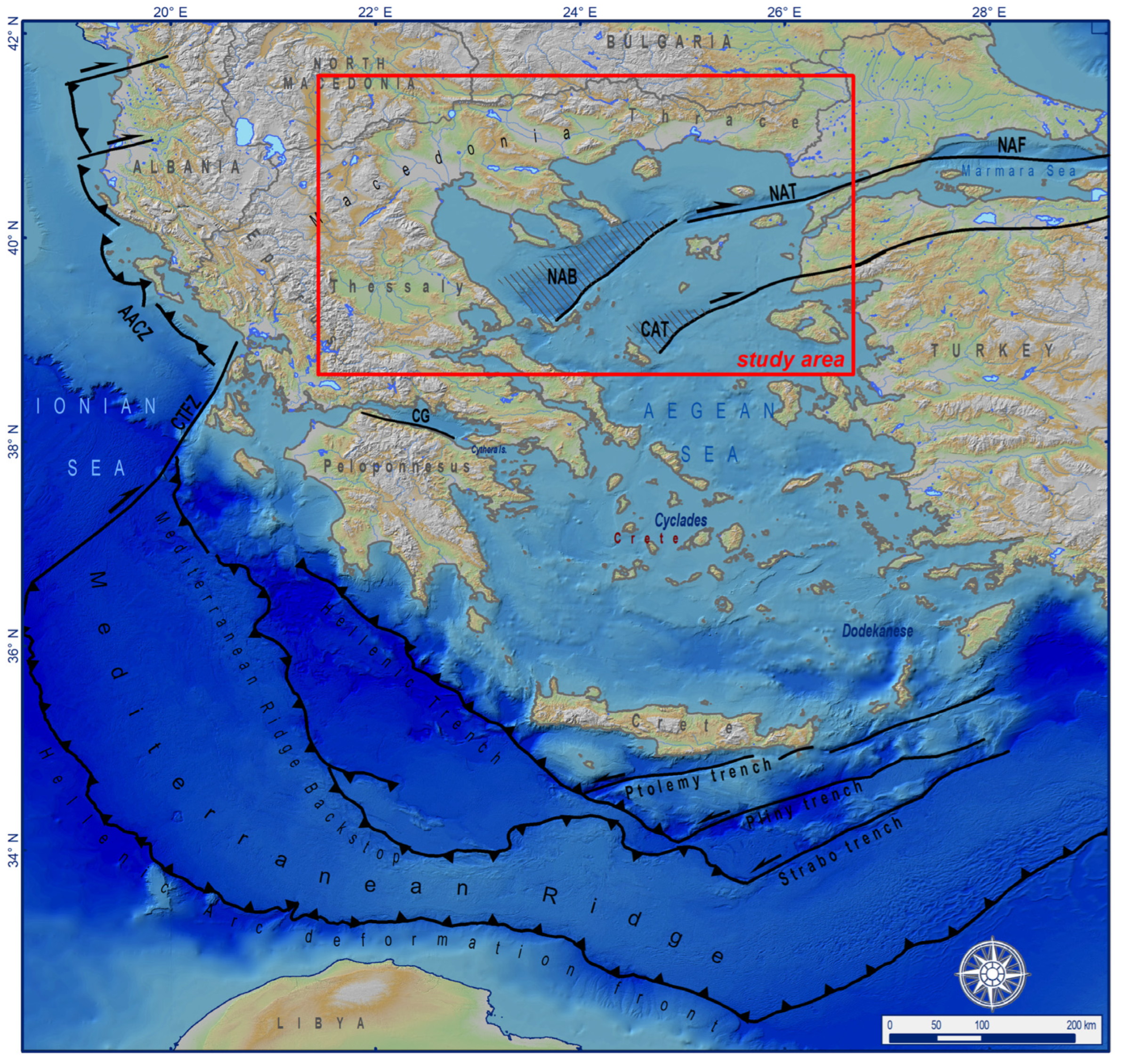
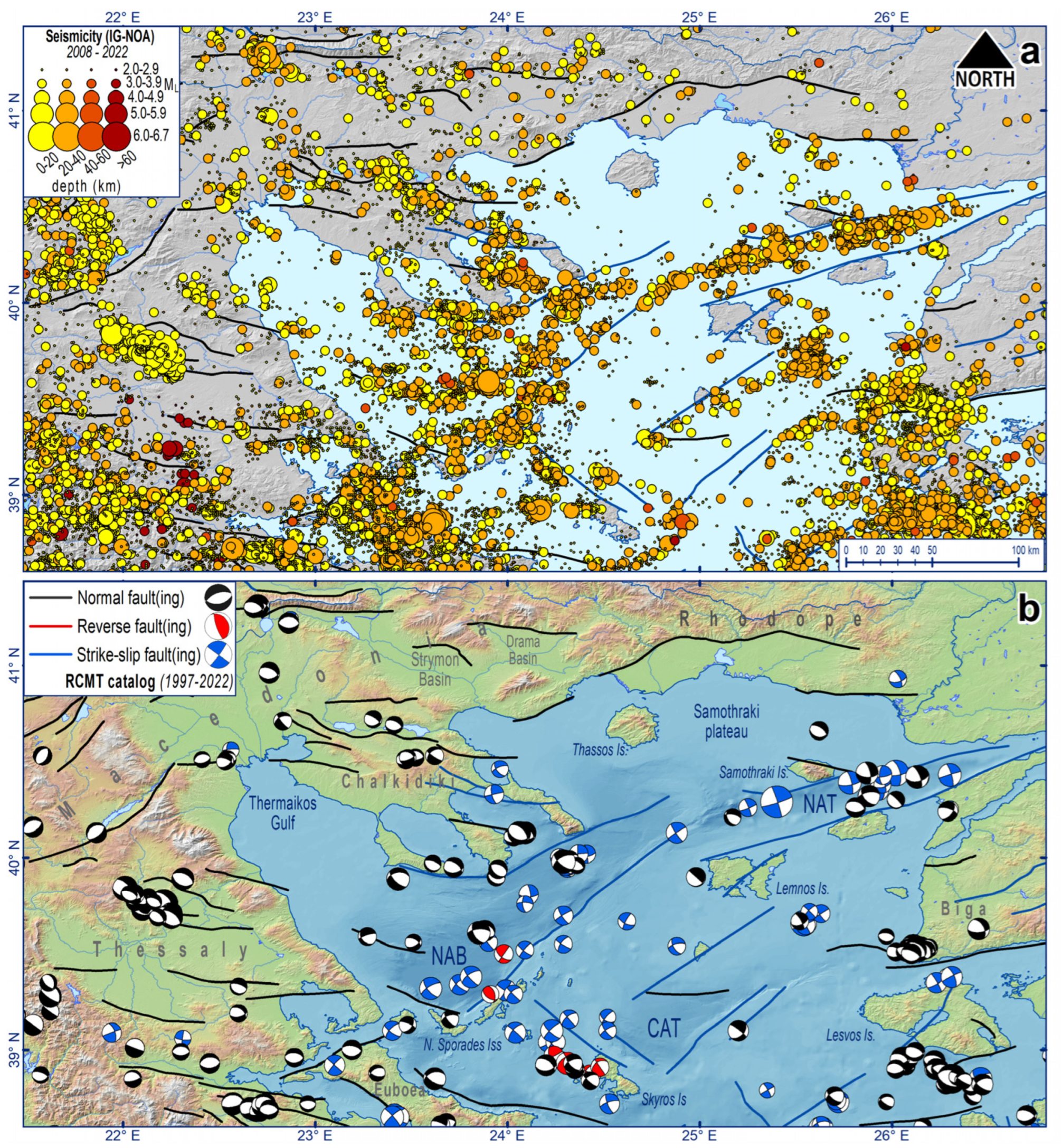
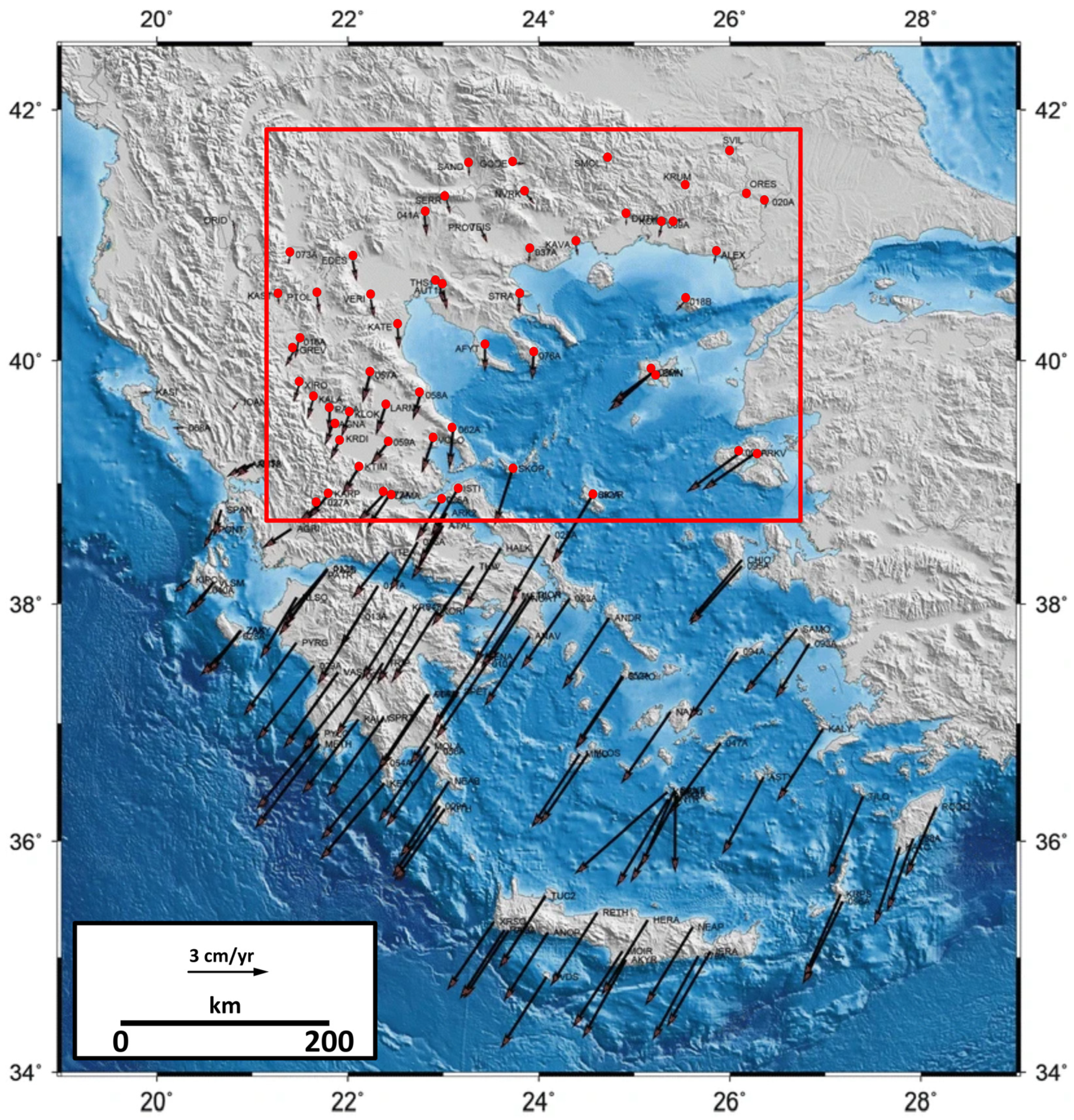
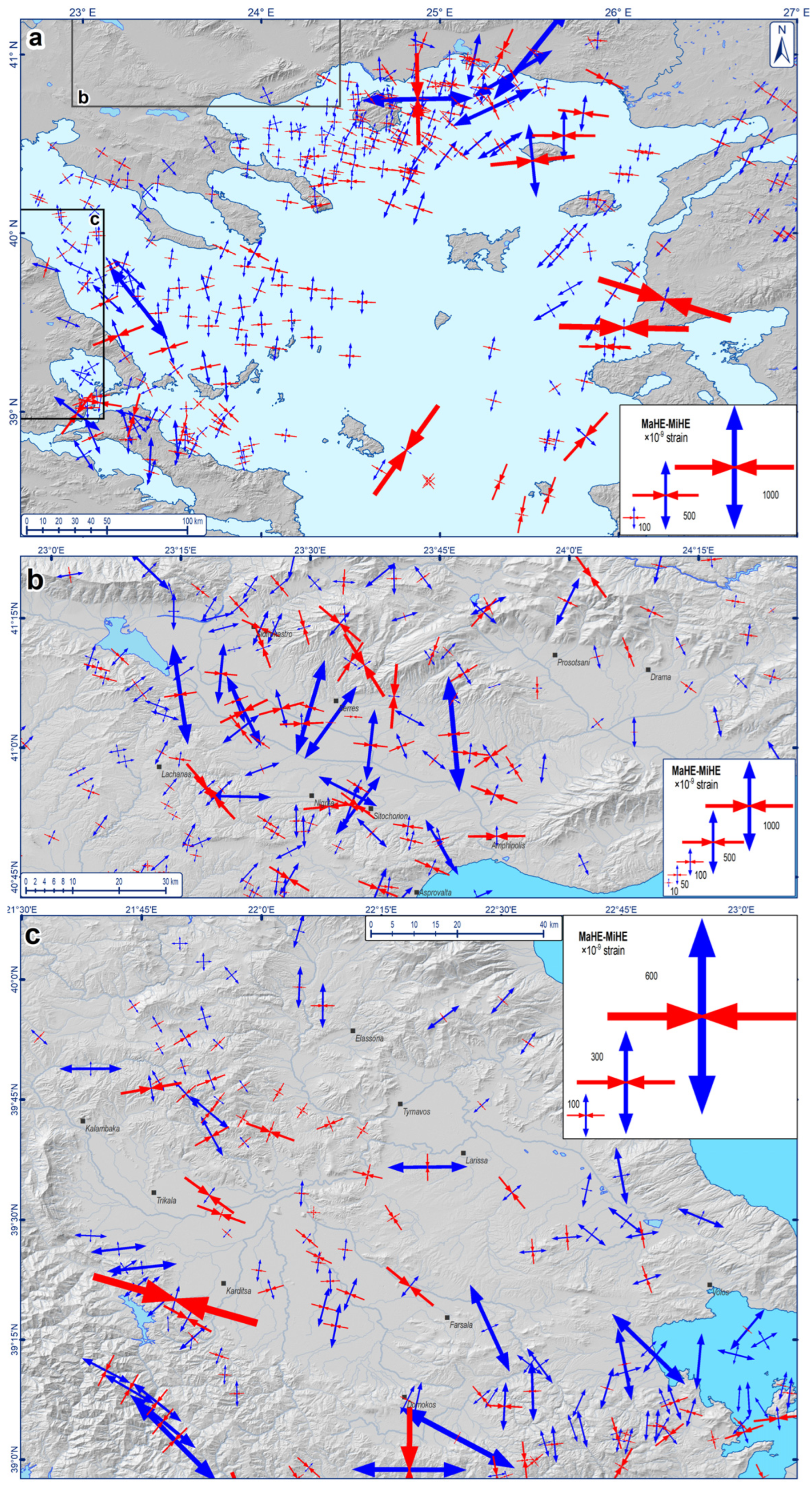

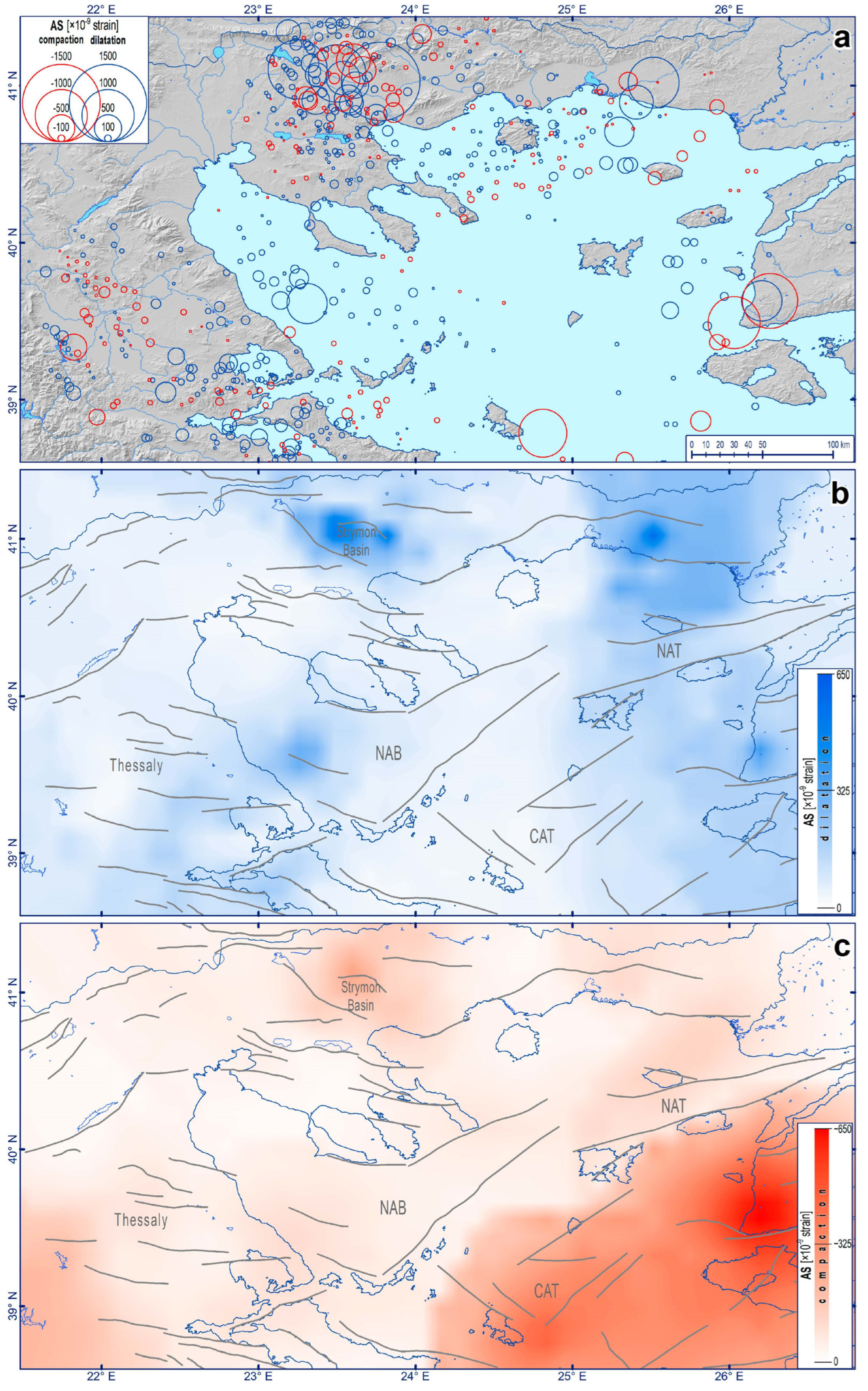
Disclaimer/Publisher’s Note: The statements, opinions and data contained in all publications are solely those of the individual author(s) and contributor(s) and not of MDPI and/or the editor(s). MDPI and/or the editor(s) disclaim responsibility for any injury to people or property resulting from any ideas, methods, instructions or products referred to in the content. |
© 2023 by the authors. Licensee MDPI, Basel, Switzerland. This article is an open access article distributed under the terms and conditions of the Creative Commons Attribution (CC BY) license (https://creativecommons.org/licenses/by/4.0/).
Share and Cite
Lazos, I.; Sboras, S.; Pikridas, C. Tectonic Geodesy Synthesis and Review of the North Aegean Region, Based on the Strain Patterns of the North Aegean Sea, Strymon Basin and Thessalian Basin Case Studies. Appl. Sci. 2023, 13, 9943. https://doi.org/10.3390/app13179943
Lazos I, Sboras S, Pikridas C. Tectonic Geodesy Synthesis and Review of the North Aegean Region, Based on the Strain Patterns of the North Aegean Sea, Strymon Basin and Thessalian Basin Case Studies. Applied Sciences. 2023; 13(17):9943. https://doi.org/10.3390/app13179943
Chicago/Turabian StyleLazos, Ilias, Sotirios Sboras, and Christos Pikridas. 2023. "Tectonic Geodesy Synthesis and Review of the North Aegean Region, Based on the Strain Patterns of the North Aegean Sea, Strymon Basin and Thessalian Basin Case Studies" Applied Sciences 13, no. 17: 9943. https://doi.org/10.3390/app13179943
APA StyleLazos, I., Sboras, S., & Pikridas, C. (2023). Tectonic Geodesy Synthesis and Review of the North Aegean Region, Based on the Strain Patterns of the North Aegean Sea, Strymon Basin and Thessalian Basin Case Studies. Applied Sciences, 13(17), 9943. https://doi.org/10.3390/app13179943







